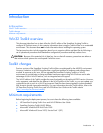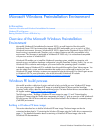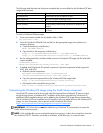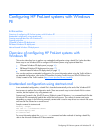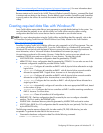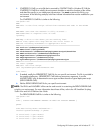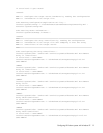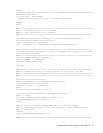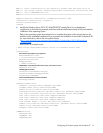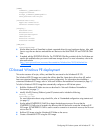
Configuring HP ProLiant systems with Windows PE 9
(http://www.microsoft.com/licensing/programs/sa/support/winpe.mspx). For more information about
the net use command, enter net help use at the command prompt.
Because startnet.cmd is stored in the WinPE_Directory\Platform\system32 directory, command files listed
in startnet.cmd are relative to the directory. Use the default system variables SystemDrive and SystemRoot
to specify paths to the utilities. Be sure that the contents of the file are accurate and tested before using it
widely.
Creating required data files with Windows PE
Some Toolkit utilities require data files as input arguments to provide detailed settings for the system. You
can build data files manually to use with the utilities, but Toolkit utilities can also capture existing
configuration data files from a server that can then be customized to use with other servers.
NOTE: For more information about using the Toolkit utilities and building data files manually, refer to the
HP SmartStart Scripting Toolkit Linux and Win32 Editions User Guide, located on the Toolkit website
(http://www.hp.com/servers/sstoolkit
).
SmartStart Scripting Toolkit Win32 Edition utilities are only supported in a Win32 environment. They can
run in either Windows® or Windows® PE. To use the Toolkit utilities in a Windows® PE environment,
Windows® PE must be built with the latest HP drivers to ensure the utilities can access the hardware. For
more information, refer to "Microsoft Windows Preinstallation Environment (on page 5)."
No restrictions are placed on file naming. However, if data files for various servers are placed on an
installation CD-ROM, store each server profile in its own directory. The data files include:
• HWCONFIG.XML—Hardware configuration data file generated by CONREP
• ARRAYCFG.INI—Array configuration data file generated by CPQACU. You can also use one of the
automatic configuration sample files provided with the Toolkit:
• PL-R0.INI—Configures all controllers as RAID 0 with all physical drives allocated to a single
logical drive.
• PL-R1.INI—Configures all controllers as RAID 1 with all physical drives on each controller
allocated to separate RAID 1 logical drives. Assumes two or more physical drives.
• PL-R5.INI—Configures all controllers as RAID 5 with all physical drives on each controller
allocated to a single logical drive. Assumes three or more physical drives.
• PL-RD1.INI—Configures the first controller as RAID 1 with all physical drives allocated to a
single logical drive.
• PL-RD.INI—Automatically configures all controllers to the most appropriate RAID level, based
on the number of drives.
• PL-R1R5.INI—Configures the first two controllers as RAID 1 and the remaining controllers as
RAID 5. Assumes 5 or more drives.
• ERASE.INI—Clears all controllers of all configurations.
• DISKPART0.TXT—Partition configuration data file created by the user to configure a bootable
partition. This file is used by the DISKPART utility.
• HWDISC.XML—Hardware discovery data file generated by HWDISC.EXE and used at runtime
• ILOCFG.XML—RILOE II or iLO configuration data file created by the user (optional). This file is used
by the HPONCFG utility.
The following examples assume a floppy disk, but other media (CD, PXE, USB drive key) are also
acceptable. To generate the data files on the source server:
1. Generate the hardware configuration data file with the following command:
CONREP /S A:\HWCONFIG.XML






